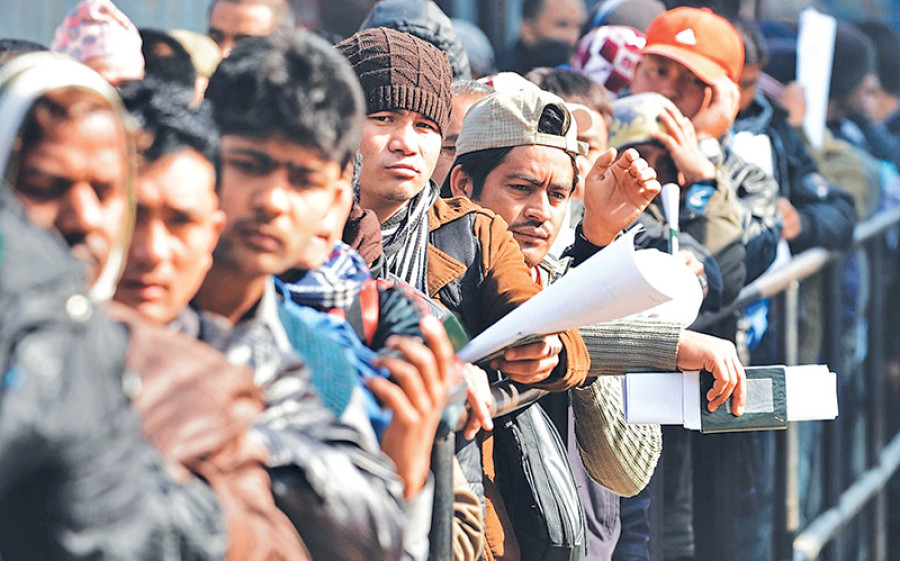Opinion
Burning issue
Over the years, foreign labour migration has proven alluring for many Nepali youths who wish to fulfil their dreams of achieving better livelihoods.
Prakash Bhattarai, Reshma Basnet & Vivek Adhikari
Over the years, foreign labour migration has proven alluring for many Nepali youths who wish to fulfil their dreams of achieving better livelihoods. It is estimated that, in the past 20 years, about six million Nepalis have left the country for foreign employment and have journeyed to more than 110 destination countries. As an increasing trend with rapidly changing dynamics, the issue of foreign labour migration and its management has become a burning issue in Nepal.
Increasing necessity
Migration governance refers to the act or practice of controlling and regulating the overall aspects of migration primarily for the purpose of ensuring the wellbeing of current and/or returnee migrants and the foreign employment entrepreneurs. With the increasing number of labour migrants seeking employment opportunities, migration governance is something that demands attention.
It is estimated that around 1,500 youth leave the country every day for foreign employment. Based on the data of Department of Foreign Employment (DoFE) on number of work permits issued in the last 10 years, a significant annual increase in numbers can be seen. Where only 219,965 permits were issued in the year 2008/09, the number surged to 423,122 in 2012/13.
Remittances sent home by migrant workers contribute greatly to the national economy of Nepal, and its contribution to the household economy is even more significant. According to a macroeconomic report of Nepal Rastra Bank, remittances made up 31.57 percent share in the GDP of Nepal in 2015, with an average per day remittance inflow going up to 2.10 billion Nepali Rupees.
However, with the increasing number of labour migrants, the issues and problems they face are also increasing significantly. Cases of fraud, human trafficking, exploitation, abuse, and even deaths amongst migrant workers make frequent headlines. According to the Foreign Employment Promotion Board (FEB), a total of 1,002 cases of migrant worker deaths were reported in the year 2014/15 alone. The problems of migrants however, aren’t limited to the destination countries, as the government is also failing to arrange proper re-integration mechanism of migrants upon return, compelling them to seek opportunities at new destinations or return to their old destinations.
Limited physical, human, and economic resources, insufficient initiatives, political instability, and lack of monitoring of policy implementation adds to the difficulty of the aspiring labour migrants within the country, as well as those already working abroad.
The formal process of governing seems to have been initiated with the establishment of the Ministry of Labour and Social Welfare in 1981. This ministry is currently operating as the Ministry of Labour and Employment (MoLE). The state tried to regulate the process of migration governance through the Foreign Employment Act in 1985 for the first time; this mainly focused on regulating those involved in the foreign employment business. So the formal history of labour migration in Nepal is almost 30 years long. The occasional amendment of employment acts, the changes in policies, signing of bilateral agreements and MoUs reflect the government’s effort towards better governance of labour migration. During this period, many key institutions responsible for the management and regulation of foreign employment business have also been established, including MoLE, FEB, DoFE, and Foreign Employment Tribunal. Establishment of Nepali embassies in the destination countries and provision of labour attachés can also be seen as efforts towards improving migration governance.
Steps to take
Draft preparation for amending the Foreign Employment Act 2007, initiation of distributing the labour permit through an online system, bilateral discussions with destination countries, and government seeking financial transaction of manpower agencies in order to investigate the implementation of free-visa and ticket policy are some commendable attempts the government has made to address the emerging issues of foreign labour migration. Also, the announcement of treatment facilities for migrant workers and members of their families, and an increase of insurance for migrant workers are positive steps.
However, the existing initiations and interventions of the government are not sufficient in dealing with the magnitude of the existing problems. All the facilities provided by governmental organisations are centralised within the Kathmandu Valley which has made it difficult and expensive for many migrant workers to access these services. In such scenario, decentralisation is a must to ensure that everyone has access to the services they deserve. There is also a lack of effective provisions to disseminate information about the opportunities and threats posed by the destination countries.
Though policies and programs have been drafted to protect and promote the rights of migrant workers, its implementation and monitoring seems to be lagging. Recruitment agencies are often seen exploiting the aspiring migrants rather than facilitating the process, which invites the need of regular and effective monitoring mechanisms. There is also an urgent need for the government to initiate the process of signing an MoU with the remaining destination countries for effective regulation of a uniform mechanism to ensure the rights of our migrant workers. The Nepali embassies in the host countries also need to be more efficient and reliable.
The government has taken significant steps over the past few years which have provided some relief to migrant workers throughout various stages of the migration cycle, however more work remains to be done. With challenges ranging from re-integration of returnee migrants, to addressing the vulnerable issues of women labour migrants, the subject demands a focus on labour migration beyond its regular economic perception. The problem of labour migration has multiple dimensions and addressing the problems is complicated, but proper co-ordination among the governmental, non-governmental, as well as private agencies working for the welfare of migrant workers is needed to protect the interest of Nepali migrant workers.
- Bhattarai, Basnet and Adhikari are associated with a Kathmandu based social think-tank called Centre for Social Change




 16.12°C Kathmandu
16.12°C Kathmandu










